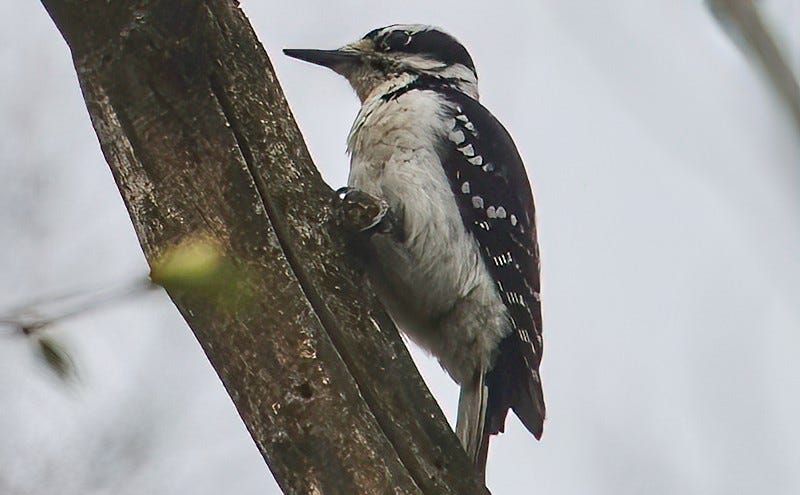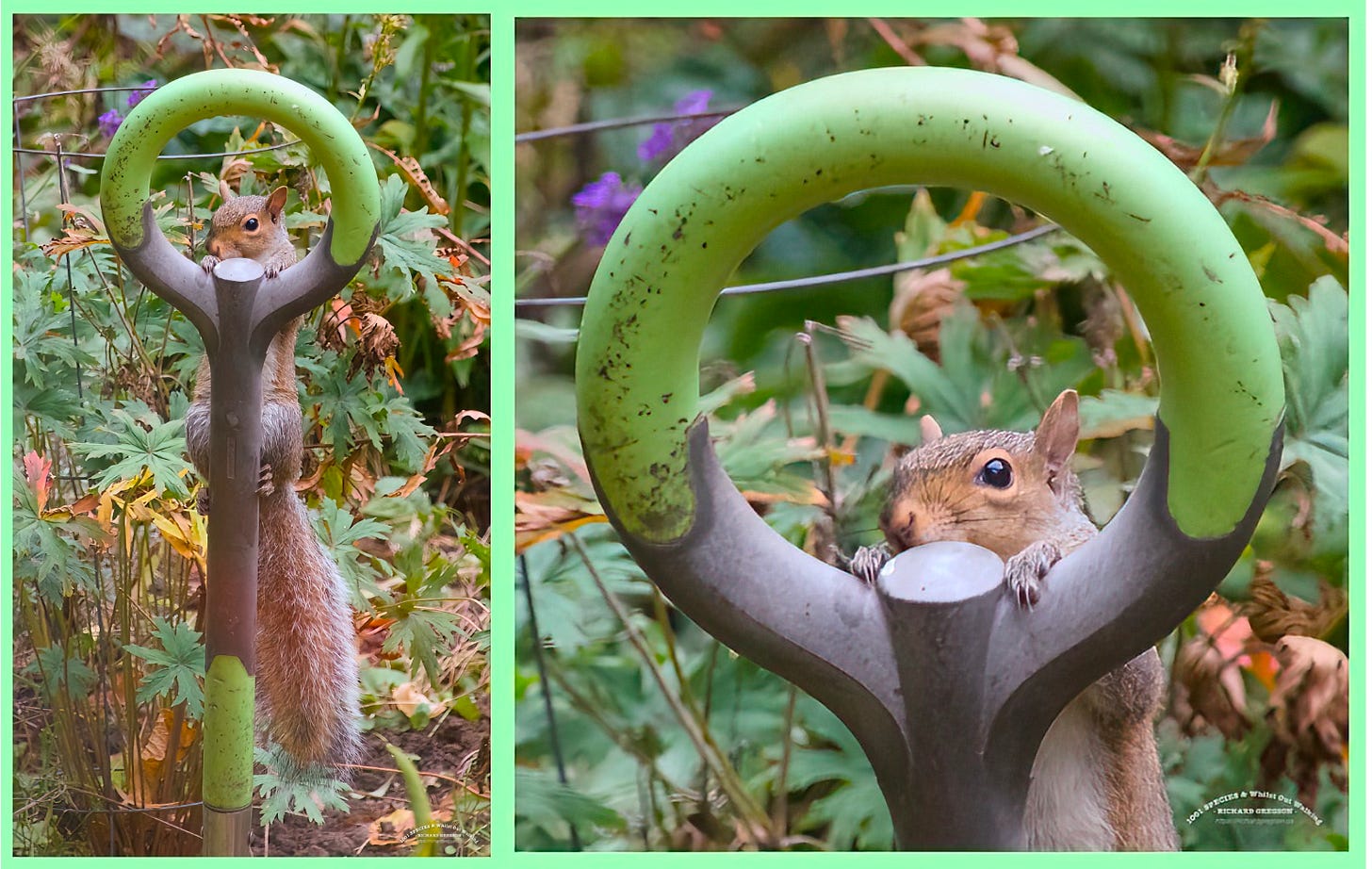I wonder sometimes if what starts each Monday with a worry about having anything to write about, then grows like Topsy as new matters come to my attention. By the next Sunday the newsletter can be too long. From this week I am reorganizing some content to try to keep things a bit more under control.
Monkshood
We were clearing out some dead Dogwood stems a few days ago and discovered a splendid example of Monkshood, still in flower. Also known as Wolf’s Bane because long ago arrows could be tipped with the extremely poisonous sap when hunting, and bait for wolves or bears would be covered with it.
You will appreciate the toxicity of this plant when you realise that the common name applies to some 250 different species of the infamously toxic genus Aconitum … this one is quite possibly Aconitum napellus. In fact “Monkshood is one of the most dangerously toxic plants there is” and, alongside the spreading Snakeweed that we cultivate, may form the backbone of a developing poison garden. Both plants have really delightful flowers - which is more than enough reason to grow them so long as we are careful. The plants are also a prime food source for the caterpillars of a wide range of moths - another excellent reason to cultivate it.
The fun bit (I wasn’t a toxicologic pathologist for nothing) is, to quote Wikipedia, that Aconitine is a potent neurotoxin and cardiotoxin that causes persistent depolarization of neuronal sodium channels in tetrodotoxin-sensitive tissues. Death usually occurs within two to six hours in fatal poisoning
Enough of that … the Canada Geese have been flying back and forth for some days now in their V-shaped formations travelling between the river and mostly the fields on the nearby Macdonald campus. Usually there are some of these big birds hanging about until the river starts to ice over and although it’s getting cold that won’t be for a while - 6C today with a wind but briefly back to 20C around the time this is published. Much bird activity in the garden with the feeders and native plant seed heads being worked over by quite large groups of Dark-eyed Juncos alongside Goldfinches, Blue Jays, Ruby-crowned Kingletsand the like. A Brown Creeper put in an appearance mid week (haven’t seen him for a couple of years) as did a Hermit Thrush and a small group of House Finches.
Rather excitingly, we have had several visits from a pair of Carolina Wrens and are hoping that they will stick around all winter as they did last year. Adding to the list is this Black-throated Green Warbler stopping off in the garden waterfall on its journey to central and southern America for winter. Not the best photo, it was taken with a trail camera while we were elsewhere.
Gardening for Food Banks
The eleventh season in our small town’s volunteer run “Garden at Fritz” has been yet another record breaker - whether because of the exceptional heat and sunshine or the skills of the gardeners or the smiling of the gods on our labours, this summer we have distributed fresh fruit and vegetable produce to food banks and others amounting to some 5929 lbs (well on the way towards 3 tons) with an estimated retail value of $19,666
There is an album of photographs here: https://flic.kr/s/aHBqjBNFc4
In the interests of not being overly prolix, what follows is stuff that I found interesting - some readers just may find something that appeals to to them … have a browse:
Some species are not quite as closely related as you might think
Downy Woodpeckers look just like slightly smaller versions of Hairy Woodpeckers so it is natural to assume they are related, which they are … but evolution is a strange thing, and it is now considered that the smaller Downy evolved to look like the Hairy in order to take advantage of the size advantage that the Hairy has in interactions with other birds competing for resources. Downies have also evolved to be bigger bullies than their larger cousins. Rather than fooling Hairys directly, Downys are using their doppelgänger good looks to pass as bigger birds and scare off non-woodpecker rivals.
https://www.audubon.org/news/theres-new-theory-why-downy-and-hairy-woodpeckers-look-so-alike
Missed from our climate calculations
We console ourselves in these years of climate change with the assumption that the trees and green plants in general are busily absorbing CO2 and in some ways saving the planet from our activities - all we have to do is to plant more trees and we will come out fine at the other end. Well, not so. It seems that trees and land absorbed almost no CO2 last year. The sudden collapse of carbon sinks was not factored into climate models – and could rapidly accelerate global heating. Only one major tropical rainforest – the Congo basin – remains a strong carbon sink that removes more than it releases into the atmosphere. Exacerbated by El Niño weather patterns, deforestation and global heating, the Amazon basin is experiencing a record-breaking drought, with rivers at an all-time low. Expansion of agriculture has turned tropical rainforests in south-east Asia into a net source of emissions in recent years.
“We shouldn’t rely on natural forests to do the job. We really, really have to tackle the big issue: fossil fuel emissions across all sectors,” says Prof Pierre Friedlingstein of Exeter University, who oversees the annual Global Carbon Budget calculations. “We can’t just assume that we have forests and the forest will remove some CO2, because it’s not going to work in the long term.”
The “Three Fs”
We are long used to speaking of Flora and Fauna- now we must become used to adding the “other F” by including that massive Kingdom occupied by the world’s fungi which are not plants, and not animals. This interesting article explains the justification for Flora, Fauna and Funga as we go forward.
There is hopefully, and soon, to be a “pledge for fungal conservation”, arguing for the “recognition of fungi as an independent kingdom of life in legislation, policies and agreements, in order to advance their conservation and to adopt concrete measures that allow for maintaining their benefits to ecosystems and people in the context of the triple environmental crisis.”
To close - a curious squirrel
… he hung around playing peek-a-boo for several minutes. Long enough for J to call me and then for me to find the camera, before he wandered away. Wonder what was happening in that small brain?
Simply October’s Garden Flowers











Loved the bit on Downys and Hairys. Now I’ll have to keep an eye out on who is bullying who.
Nice to see those migrating birds!